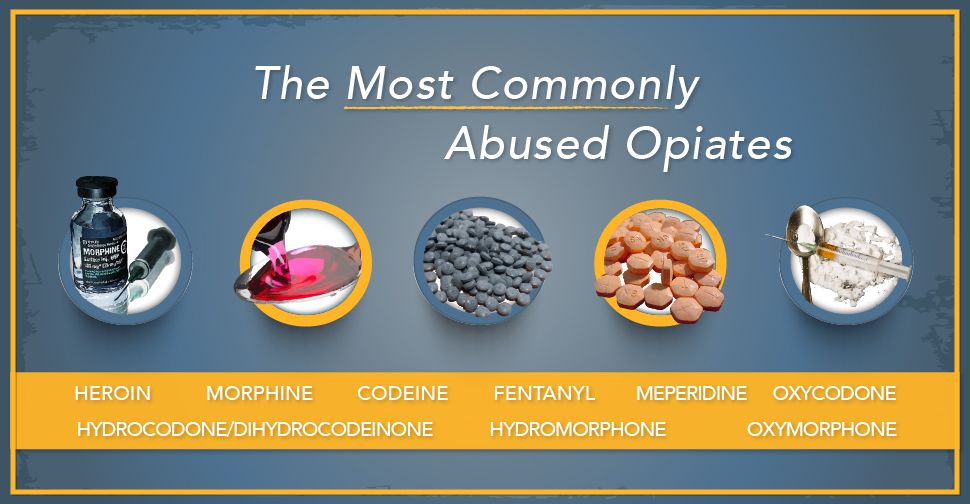
Opiates are found in the opium poppy plant Papaver Somniferum. The flowering plant contains the psychoactive compounds morphine, codeine, and thebaine. The different formulations of prescription opiate drugs work to treat various levels of pain. Although opiate pain treatments are effective when used as directed, the risk of dependence is very high if misused.
Misuse of a prescription medication includes taking a drug in a different way (e.g. crushing a tablet and snorting) or in a greater quantity than prescribed. Taking a prescription medication that is prescribed to someone else also constitutes abuse. Opiate abuse can cause serious implications, including respiratory failure, coma, or even death. The most commonly abused opiate drugs include:
Heroin
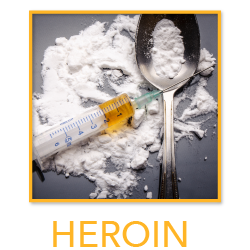 Heroin (Diacetylmorphine) is a synthesized form of morphine, and the most frequently abused non-prescription opioid substance. Heroin can be found in a white, off-white, or brown powder. The black sticky substance that is produced from incomplete acetylation of morphine is called “black tar heroin.”
Heroin (Diacetylmorphine) is a synthesized form of morphine, and the most frequently abused non-prescription opioid substance. Heroin can be found in a white, off-white, or brown powder. The black sticky substance that is produced from incomplete acetylation of morphine is called “black tar heroin.”
Heroin is commonly heated with a spoon and lighter, then injected into the bloodstream through a hollowed needle. In some cases, the drug is smoked or snorted. Heroin is known on the streets as “Brown Sugar,” “China White,” “Dope,” “H,” “Horse,” “Junk,” “Skag,” “Skunk,” “Smack,” and “White Horse.” When combined with over-the-counter cold medicine and antihistamine, the drug is referred to as “Cheese.”
Morphine
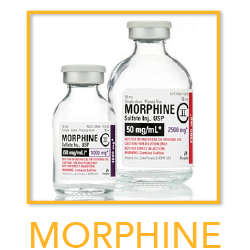 Morphine is a naturally-occurring substance extracted from the pod of Asian poppies. Brand names for morphine include MS-Contin (extended-release tablet), Duramorph (injection), and Roxanol (liquid/pill).
Morphine is a naturally-occurring substance extracted from the pod of Asian poppies. Brand names for morphine include MS-Contin (extended-release tablet), Duramorph (injection), and Roxanol (liquid/pill).
Morphine is distributed in a tablet, liquid, capsule, or suppository. Oral and intravenous administration is the routine method for medical use. When used non-medically, morphine tablets are often crushed and snorted, or smoked. Street terms for morphine include “M,” “Miss Emma,” “Monkey,” and “White Stuff.”
Codeine
 Codeine is a narcotic pain reliever similar to morphine from the opioid alkaloids found in the opium poppy. The medicine also works to control the cough reflex in severe respiratory infections. Tylenol 3/4/5 (tablet/capsule) and Robitussin AC (liquid) are common brand names.
Codeine is a narcotic pain reliever similar to morphine from the opioid alkaloids found in the opium poppy. The medicine also works to control the cough reflex in severe respiratory infections. Tylenol 3/4/5 (tablet/capsule) and Robitussin AC (liquid) are common brand names.
Codeine is often injected or swallowed. When taken orally, the drug is often mixed with soda or other flavored drinks. Codeine is also known as “Captain Cody,” “Lean,” “Schoolboy,” “Sizzurp,” “Purple Drank.” When mixed with the hypnotic sedative glutethimide, the resulting syrup concoction is referred to as “Doors and Fours,” “Loads,” and “Pancakes and Syrup.”
Are you or a loved one suffering from addiction?
Don't wait, get the best treatment options today
Call Now: (833) 473-4227Fentanyl
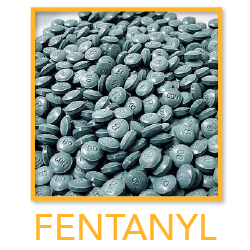 Fentanyl is a fast-acting analgesic and sedative intended to relieve severe pain. The narcotic is sometimes abused due to its similarities with heroin. Fentanyl is available under the brand names Actiq (oral “sucker”), Duragesic (patch), and Sublimaze (injection).
Fentanyl is a fast-acting analgesic and sedative intended to relieve severe pain. The narcotic is sometimes abused due to its similarities with heroin. Fentanyl is available under the brand names Actiq (oral “sucker”), Duragesic (patch), and Sublimaze (injection).
The drug is commonly injected, smoked, or snorted when misused. The street names for Fentanyl are “Apache,” “China Girl,” “China White,” “Dance Fever,” “Friend,” “Goodfella,” “Jackpot,” “Murder 8,” “Tango and Cash,” and “TNT.”
Hydrocodone/Dihydrocodeinone
Hydrocodone dihydrocodeinone is a schedule II semi-synthetic opioid synthesized from codeine. These drugs are frequently used for pain relief and as cough suppressants. The effects of hydrocodone are usually experienced within 20-30 minutes of administration and last about 4-8 hours, depending on dosage. The manufacturer recommends dosing every 4-6 hours as needed for pain relief. Brand names for hydrocodone medications are Vicodin (tablet), Lortab (tablet), and Lorcet (tablet).
Hydrocodone can be found in capsule, liquid, and tablet form. The most common route of administration is by mouth, intravenously, or snorted. Hydrocodone is sometimes referred to as “Vike” and “Watson-387.”
Hydromorphone
Hydromorphone is a synonym for dihydromorphinone, a derivative of morphine. This semi-synthetic opioid medication is used to treat moderate to severe pain. Brand names for hydromorphone include Dilaudid (tablet/suppository/liquid), Exalgo (tablet), and Palladone (capsule).
The drug is routinely used via IV in a hospital setting. While hydromorphone can be taken orally or rectally, the bioavailability is much less than that of an intravenous administration. Street names for hydromorphone include “D,” “Dillies,” “Footballs,” “Juice,” and “Smack.”
Meperidine
 The brand name for the narcotic analgesic Meperidine is Demerol, which has been used for decades to alleviate moderate to severe pain experienced in childbirth, accidents, and during cancer treatments. Demerol is available in tablet or liquid form, most often administered in a hospital setting via IV drip.
The brand name for the narcotic analgesic Meperidine is Demerol, which has been used for decades to alleviate moderate to severe pain experienced in childbirth, accidents, and during cancer treatments. Demerol is available in tablet or liquid form, most often administered in a hospital setting via IV drip.
Because of the high likelihood of dependence and overdose, Demerol is rarely prescribed outside of a hospital. The drug is often swallowed, snorted, or injected when misused. Demerol is also known as “Demmies” on the street.
Methadone
Methadone is a long-acting full agonist opioid designed to treat the painful effects of opiate withdrawal. Methadone works to produce opioid effects on receptors in the brain until fully activated or the maximum effect is reached. This is thought to stave extreme withdrawals to aid in the recovery process.
Common methadone brands include Dolophine (tablet), Diskets (dissolving tablet), and Methadose (liquid). Methadone is often swallowed or injected when misused. Street names for methadone include “Amidone” and “Fizzies.” When mixed with MDMA, the concoction is called “Chocolate Chip Cookies.”
Oxycodone
Oxycodone is a narcotic medication used to alleviate severe pain. Due to the increase in oxycodone prescriptions (82 percent between 2007-10), nearly 183,000 visits to emergency rooms across the US were the result of oxycodone misuse in 2010. Brand names for oxycodone include Oxycontin, Percodan, Percocet, Endocet, and Xartemis XR (tablets).
Oxycontin comes in capsule, liquid, and tablet form. Common methods of administration include oral, injection, and snorted through the nose. Street names for oxycontin include “O.C.,” “Oxycet,” “Oxycotton,” “Oxy,” “Hillbilly Heroin,” or “Percs.”
Oxymorphone
Oxymorphone is a semi-synthetic opioid analgesic developed in Germany in 1914. The formula was patented in the US by Endo Pharmaceuticals in 1955 and distributed to the market in 1959. Under the brand name Opana (extended release/immediate release), oxymorphone is most often used as a preoperative medication to ease surgical apprehension.
Oxymorphone also works to maintain anesthesia and provide pain relief during childbirth. When misused, the tablet is typically swallowed, snorted, or injected. The street names for oxymorphone include “Biscuits,” “Blue Heaven,” “Blues,” “Mrs. O,” “O Bomb,” “Octagon,” and “Stop Signs.”
Help For Abuse Of Opiates
Narcan: A Life Saver for Opiate Overdose
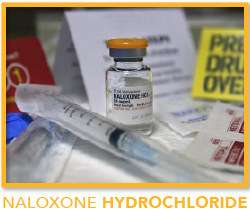 Narcan (naloxone hydrochloride) is an opioid antagonist medication used to treat the effects of an opiate overdose. When used in an emergency, Narcan is administered via nasal spray to help stave the instance of respiratory distress. Narcan is not a substitute for emergency medical assistance, however, the drug can “buy time” before medical intervention is available.
Narcan (naloxone hydrochloride) is an opioid antagonist medication used to treat the effects of an opiate overdose. When used in an emergency, Narcan is administered via nasal spray to help stave the instance of respiratory distress. Narcan is not a substitute for emergency medical assistance, however, the drug can “buy time” before medical intervention is available.
Narcan, or naloxone hydrochloride, is widely used by emergency response teams to quickly restore respiration to a person whose breathing has slowed or stopped due to overdose. Sometimes, it is too late before EMTs are able to make it to the overdose victim.
When Narcan is given directly to the patient using the opioids as a preventative measure, friends and family have the drug on hand to administer in case of emergency. This method has been proven effective in saving lives.
Buprenorphine (Suboxone and Subutex)
Buprenorphine is a partial opioid agonist used to treat opiate addiction. A partial agonist works by interacting with the same receptors in the brain as opioid drugs. This method tricks the brain into believing it is receiving opioids without the disorienting high.
Under the brand names Suboxone and Subutex, buprenorphine is prescribed by a physician for at-home use. Suboxone and Subutex both contain the active ingredient buprenorphine. Suboxone also contains a substance called “naloxone,” a medication used to block opiate drugs from sticking to opioid receptors. This quality makes Suboxone a popular choice among physicians as a method of opioid treatment.
In contrast to methadone maintenance treatment, Suboxone allows those in recovery to quickly return to daily life. Prescription maintenance of Suboxone is once monthly, as opposed to every day or two with methadone treatment. Suboxone also bolsters sobriety by preventing those in recovery from abuse of other opioids and itself.
We Can Help
 It’s difficult to imagine addiction if you’ve never experienced it for yourself. Many good people fall victim to the powerfully addictive qualities of opiate drugs every day. If you or a loved one is struggling with opioid addiction, the caring staff at DrugRehab.org is here for you. We can offer support, guidance, and resources in your area to help you find relief from addiction. Contact us today.
It’s difficult to imagine addiction if you’ve never experienced it for yourself. Many good people fall victim to the powerfully addictive qualities of opiate drugs every day. If you or a loved one is struggling with opioid addiction, the caring staff at DrugRehab.org is here for you. We can offer support, guidance, and resources in your area to help you find relief from addiction. Contact us today.

